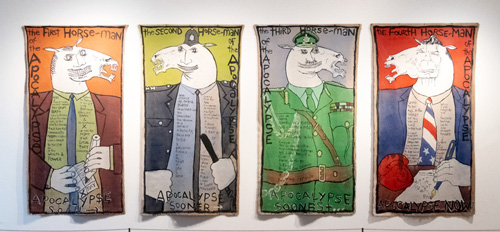
From ancient Greek mythology we encounter the figure of Kassandra (Κασσάνδρα), more commonly spelt Cassandra. She was one of the many offspring of King Priam of Troy and Queen Hecuba, and sister to Hector and Paris. Legend places Kassandra as a priestess to the God Apollo.
According the ancient Greek playwright Aeschylus, Apollo developed a sexual interest in Kassandra, and enticed her with the gift of prophecy in exchange for the promise of intimacy. However, when Kassandra spurned Apollo’s advances, he added a cruel twist to the gift. Kassandra would clearly see the future but would always be disbelieved in her prophecies. As Laurie Layton Schapira points out in ‘The Cassandra Complex’ “when Apollo breathed into Cassandra’s mouth.. though he left with her the power of foretelling the future, he took from her the power of persuasion” (p47)
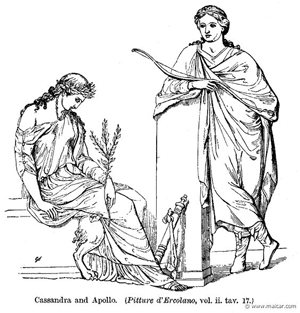
This dilemma of foresight met with disbelief, was apparently first reconnected to the name of Cassandra in 1914 by Charles Oman, in his book ‘History of the Peninsula War Volume 5’. Here we encounter an account of ‘Cassandra-like’ prophecies being dismissed as ‘wild and whirling words’ (p195).
The identification of what became known as the ‘Cassandra Syndrome’ is attributed to the French Philosopher Gaston Bachelard in his book ‘Le rationalisme appliqué’ (1949). In this, he applied it to cases of people, who like Cassandra and her warnings of the Greeks hiding in the wooden horse in Troy, are ignored and dismissed as also uttering ‘wild and whirling words’.
The memory of Cassandra as embodied within the ‘Cassandra-Syndrome’, has become apt in the light of that various contemporary threats that remain ignored, with their identification dismissed as the ‘wild and whirling words’ of a marginal few. Conversations around issues such as climate change, environmental degradation, social and economic inequalities, mass extinction of species and rampant militarism are often simply ignored, greeted with scepticism, or drowned out by the relentless roar of the ‘everyday’.
In the moment of Global Pandemic in the wake of the rapid spread of Covid-19, issues around how we hear and respond to voices of dire warning has become a key part of contemporary discourse. The role, identity and utterances of modern day Cassandra-like figures, becomes all the more pertinent. This is a key aspect of this project.

St John on Patmos. Sandro Botticelli 1490-1492
We move now from the Greek writings of Aeschylus, the ‘father of tragedy’, half a millennium forward to another body of writing in Greek, this time from a figure known as John of Patmos (Ἰωάννης ὁ Θεολόγος). There remains debate around the identity of this character, with Christian literalists assuming him to be John the Apostle ( וחנן שליחא Yohanān Shliḥā;). However, the evidence for this is seen by many scholars as tenuous
Whatever his identity, John of Patmos has left us with what is described in Greek as an ‘apokalypsis’, (ἀποκάλυψις ) meaning an ‘uncovering’ or ‘Revelation’. This body of writings dates it is thought, from the reign of Roman Emperor Domitian, approximately AD 81-96.
After slow and disputed process, these writings were finally accepted as ‘Canonical’ by Eusebius in his Church History of AD 330. By the time of the Council of Rome of AD 382, the ‘Apocalypse of John’ appears on the ‘Damasine list’ detailing "the divine Scriptures, what the universal Catholic Church accepts” and secured its status as the final ‘book’ in what became the Christian ‘Bible’.
‘The Apocalypse of St John’ or as it is more widely know, ‘The Revelation of St John’ is a book dense in strange symbolism and obtuse language. It is the very personification of the ‘wild and whirling words’ signposted by Charles Oman in 1914 with a labyrinthine structure and obscure coded metaphors that have fuelled speculative readings for centuries. Opposite to Cassandra, whose warnings were dismissed as hysterical babbling, the strange multi-headed beasts, proclaiming angels and descriptions of Apocalyptic torments of ‘The Book of the Revelation of St John’ have remained the subject of generational scrutiny.
Six chapters into the swirling and convoluted imagery of the ‘Apokalypsis of St John’ we are presented with a narration of the opening of a ‘scroll’ fastened with ‘seven seals’. On the opening of each of the first four of these ‘seals’ a figure on horseback gallops into view.
Each figure carries a set of specific objects, and the horses are sequentially coloured, white, red, black and finally a pale grey. These are what have come to be known as ‘The Four Horsemen of the Apocalypse’.
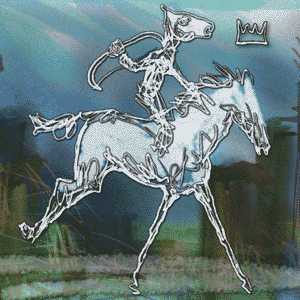
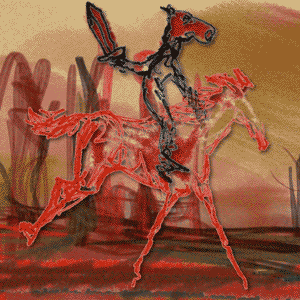
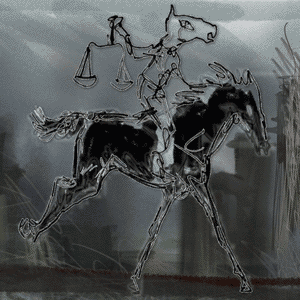
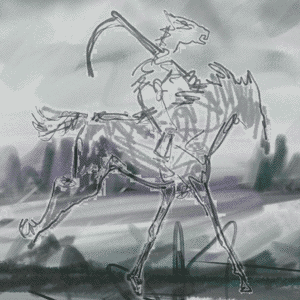
As a Hebrew scholar and theologian, John of Patmos would have been familiar with the symbolism of the four horsemen from the Tanakh where Zkharyāh (זְכַרְיָה) (The Prophet Zechariah) mentions four coloured horses with riders or pulling chariots, each given a geo-political mission. He would have also been familiar with the writings of Yĕkhezqiēl (יְחֶזְקֵאל) (The Prophet Ezekiel) who speaks of, "four disastrous acts of judgment" (ESV), sword, famine, wild beasts, and pestilence, against the idolatrous elders of Israel.”
Quoting and recycling these symbolic riders into his own Apocalyptic narrative therefore made sense for this author, and his use of them as the bearers of encoded political messages forewarning of catastrophe has become in itself a repeatable trope within Apocalyptic narratives ever since.
It is a trope that I have used in my own practice. Amidst the heightened anxieties of the mid 1980s surrounding the Nuclear brinksmanship of the Ronald Reagan Presidency , the siting of US Cruise Missiles at Greenham Common, and the police responses to the 1984-85 Miners Strike, I adapted the theme of the ‘Four Horsemen of the Apocalypse’ into a series of narrative banners created in November 1984.
In this case, ‘The Horsemen’ are depicted as a Tory Voter, A Police Officer, A US General, and finally Ronald Reagan with his finger on the nuclear button.
In revisiting the theme of the ‘Four Horsemen’ as an extended video work, I would like to focus on the constantly evolving act of attempting to ascribe symbolic meaning to each ‘horseman’ based on the contemporary concerns. In my 1984 work, I used the horsemen to articulate political concerns of the 1980s. In this new project, I would like to focus on how those proposed symbolic readings have evolved and fluctuated overtime, and can be reinvented once more for the present (and the ‘Jet-Black Future’)
For this, the project will be structured around a process of research, inquiry, speculation and detection. It will revisit and reimagine the historical prophetic ‘seer’ Kassandra (Cassandra) as a contemporary Researcher /Historian /Narrator /Poet figure. Traditionally, Kassandra is dismissed as a ‘Hysteric’ with her predictions and insights dismissed as the babblings of a disturbed woman. Although this revisiting of Kassandra will play upon her insights being ignored, she will be framed as the opposite of hysterical. This Kassandra will be scholarly, forensic and systematic. Her project will be to excavate dense archives of historical information and navigate pathways across contemporary informational, media and digital networks, returning with clues and knowledge.
The work becomes her journal. Her ‘Search for Four Horses.’

|
|

